Contents
Market Overview
Special Update on Russia and Ukraine
Gramercy’s investment team discusses Russia and Ukraine daily and, as you may have read in the Wall Street Journal on March 6th, Gramercy held an extraordinary meeting on Saturday, February 26th (two days after the initial invasion) to discuss the macroeconomic impacts of the invasion and its possible effects on the firm’s portfolios. Mohamed El-Erian, Gramercy’s Chair participated alongside Gramercy Founder and CIO, Robert Koenigsberger, whom you likely know has been a key player in many sovereign bond restructurings throughout his career.
As previously communicated, Gramercy sold all of its Russia and Ukraine sovereign bonds weeks before the initial invasion, and we are not currently considering buying Russian government debt. However, it is currently Gramercy’s position that Ukraine will likely remain independent in some form after the war and will receive massive financial aid from Europe and the U.S. Accordingly, we continue to evaluate and have executed on both buys and sales in Ukrainian bonds. The investment team is mindful and focused on not buying too fast, as prices could drop further, but the risk of missing out on a rebound is greater. As Robert has instructed the team, “when it feels really scary, you still have to plan the trade and trade the plan!”
Russia Index Update
As announced in our last EM Weekly, we highlighted that we would provide an update on key Russian index exclusions. JPM held a consultation and published results early last week. They will exclude Russia and Belarus from the EM Sovereign Index (EMBI), EM Local Sovereign Index (GBI-EM), EM Corporate Index (CEMBI) and ESG indices, effective March 31. Meanwhile, Russian local bonds (OFZs) had their accrued interest reduced to zero and were suspended from March 7, which led to a materially lower GBI-EM Index yield. We previously flagged that Russian equities were removed from MSCI and FTSE Russell indices, de-listed on the LSE, DAX, S&P and Dow exchanges and Bank of America also removed Russian securities from its fixed income ICE indices. This week, the Markit CDX EM consultation ended and in the next series (Series 37), Russia will be excluded (index weight was 6%). This means that Mexico, South Africa, Colombia, Chile and Peru will have slightly larger index weights, while Egypt has been added with a 2% weight.
Macro Review
U.S. inflation came in at 7.9% while the Italian PPI of 41.8% almost went unnoticed. Market participants rightly placed greater emphasis on Russia and Ukraine developments, given ongoing talks between Foreign Ministers Lavrov and Kuleba in Turkey. However, the sanctions narrative dominates and continues to escalate, so much so that Chelsea FC’s third spot in the English Premier League is looking somewhat precarious after Roman Abramovich was heavily sanctioned by the UK government. It is, of course, the conflict in Ukraine that has sparked stagflation and even recessionary concerns and the pivot by the ECB was noteworthy. This is best reflected in the spread between German bunds and Italian BTPs reaching its widest level since April 2020, or perhaps EURUSD below 1.10. What remains striking is the extent to which central banks are increasing inflation forecasts and even reacting now. The National Bank of Poland hiked by 75 bps but increased its inflation forecast for 2022 from 5.1%-6.5% to 9.3%-12.2%. This comes as Hungary’s inflation reached 8.3% and the Czech Republic inflation print was a nauseous 11.1%. In the same breath, crude oil touched $139/bbl but declined closer to $110/bbl at the end of the week. The U.S. have sought to release strategic reserves and even called the UAE and Saudi Arabia in an effort to increase OPEC+ production as Biden ordered a ban on Russian oil imports. For China, inflation is beginning to moderate at 0.9% and the PPI reading of 8.8% is now well below the October peak and the previous reading of 9.1%, although the main headline was in relation to the PBoC transferring profits to the central budget for 2022. Meanwhile, the SEC also put five Chinese firms on a provisional watch-list for delisting from U.S. exchanges that caused significant weakness in the Nasdaq Golden Dragon China Index that tumbled 10%. In any case, the HFCA notice allows for three-years to fix auditing issues. Finally, the S&P has now recorded its second worst YTD start in over 123 years, second only to 2009. Yet, the DAX posted its seventh best one-day gain on Wednesday (7.9%) in over 60 years as the focus shifts to de-grossing once again.
EM Credit Update
Emerging market sovereign credit ended the week down 0.4%, with credit spreads tightening 6 bps. Outperformers over the week were Ukraine, Ghana and Argentina, while Belarus, Russia and Tajikistan underperformed. Fitch also downgraded Russia to C from B, which is a six-notch downgrade. Russia had been rated BBB by Fitch until March 2 and has therefore been downgraded twelve-notches since then. Meanwhile, Sri Lanka devaluated the LKR rupee on two occasions by 12% but bonds eventually traded back to unchanged levels on the week.
The Week Ahead
Key fixtures next week are G10 central bank meetings. The Fed’s FOMC comes a day prior to the BoE and BoJ. Second to those three meetings, China’s industrial production and retail sales are due, but the PBoC decision is prior to that for the 1-year MLF rate (2.85%). There are also three rather key EM central bank decisions from Brazil (10.75%), Indonesia (3.5%) and Turkey (14.0%) too. Beyond that inflation out of Argentina, India, Israel, Nigeria, Poland, Romania and the Eurozone more broadly are due.
Highlights from emerging markets discussed below include: An update on Russia / Ukraine; the supportive policy of China’s National People’s Congress and Peru’s cabinet approved despite renewed impeachment efforts
Fixed Income
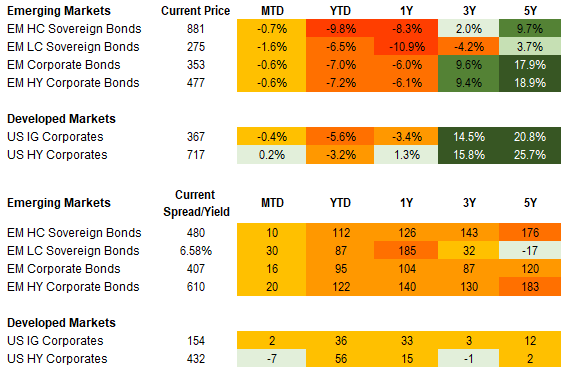
Equities
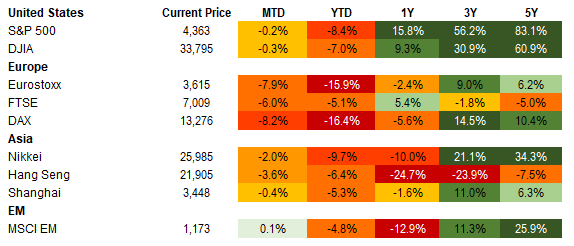
Commodities

Source for data tables: Bloomberg, JPMorgan, Gramercy. EM Fixed Income is represented by the following JPMorgan Indicies: EMBI Global, GBI-EM Global Diversified, CEMBI Broad Diversified and CEMBI Broad High Yield. DM Fixed Income is represented by the JPMorgan JULI Total Return Index and Domestic High Yield Index. Fixed Income, Equity and Commodity data is as of March 11, 2022 (mid-afternoon).
Emerging Markets Weekly Highlights
Ceasfire in Ukraine remains elusive after Foreign Ministers meet in Turkey; material Western financial support for Zelensky’s Government begins to flow
Event: A face-to-face meeting in Turkey between the Foreign Ministers of Ukraine and Russia, Dmytro Kuleba and Sergey Lavrov, failed to produce a breakthrough on ceasefire, but appeared to leave the door open for a potential direct Zelensky-Putin meeting in the future. Meanwhile, various financial support measures of significant size for Ukraine materialized during the week.
Gramercy Commentary: We were not surprised by the lack of tangible progress from the Kuleba-Lavrov meeting as the gap between Russia’s demands and Ukraine’s willingness to accommodate them remains quite large. The Kremlin appears to be sticking to a maximalist approach tantamount to Ukraine’s surrender and acceptance of all Russian conditions, while the military situation on the ground, two full weeks into Russia’s aggression, incentivizes the Ukrainian Government and people to keep resisting the invaders. In that context, we think the next phase of the conflict could be a more forceful attempt by Putin’s forces to take control of Kyiv. Ukraine’s capital is protected by well-armed and extremely motivated defenders, which suggests that a potential “battle for Kyiv” could become protracted and bloody on both sides. Even in the event Kyiv ultimately falls under Russian occupation, maintaining control will be an incredibly challenging task for the Russian forces, pointing to an active insurgency in that scenario until a peace agreement could eventually be reached. President Zelensky indicated in an interview this week that he does not expect “an end to the war” until “direct talks” between him and President Putin take place. Meanwhile, financial aid from the international community has started to materialize for Ukraine in large proportions. The IMF approved $1.4bn in emergency financing from its Rapid Financing Instrument (RFI) facility this week, which comes in addition to $730m in emergency budget support package from the World Bank. Separately, the U.S. Congress has promptly put forward a support package of close to $14bn, while UK PM Boris Johnson has spoken about a new “Marshall Plan” for Ukraine to help rebuilding the country. Our expectation is that strong financial support for Ukraine will continue to be forthcoming during and the after the active phase of the military conflict. We note that when thinking about the need for potential sovereign debt relief, investors should weigh the strong international financial support against uncertainties such as how long the conflict will last and the ultimate damage to the country’s human and physical capital, potential loss of territory, and if Ukraine would preserve access to and ability to trade via the Black Sea, a key variable for the medium-term macroeconomic outlook.
China’s National People’s Congress (NPC) points to supportive policy; FEB PPI remained elevated with upside risks ahead
Event: China unveiled its 2022 growth target of 5.5% along with a slightly narrower official fiscal deficit of 2.8% of GDP compared to 3.2% of GDP in 2021 although still plans to provide additional unofficial fiscal support worth roughly 1% of GDP via off-balance sheet public infrastructure spending and tax breaks. The general approach to financial and monetary policy is to largely be unchanged with continued incremental support to activity including further loosening of property sector measures at the local level.
Gramercy Commentary: While the growth target is seemingly ambitious amid the government’s still official zero-tolerance COVID approach and broader external developments, we expect the authorities to engineer policies in aim to bring activity roughly in line with its target. The lower market consensus and IMF growth forecasts of 5.2% and 4.8%, respectively, may be moved up slightly in context of the official target but with downside risks kept front of mind. February inflation data pointed to benign consumer pressures at 0.9% y/y although with still elevated above-expectation PPI inflation at 8.8%. We envisage a reversal of the moderate improvement witnessed in PPI in late 2021 and early 2022 on the current global commodity price backdrop resuming profit dispersion between up and downstream producers. Pass-through to CPI should remain muted given corporate constraints still leave room for marginal monetary easing.
Peru cabinet approved while renewed impeachment efforts underway
Event: Congress approved President Castillo’s fifth cabinet with 64 votes in favor and 58 votes against, the highest number of disapproving votes of all cabinets thus far. Meanwhile, opposition parties launched a motion for impeachment against Castillo while another controversial pension withdrawal bill has quietly been put forward in Congress.
Gramercy Commentary: We see the slim cabinet approval as reflective of the desire of Congress to avoid being dissolved rather than authentic acceptance of its new composition and thus, expect continuation of significant governability challenges. The support for presidential vacancy is growing with the possibility that this motion receives the 52 votes needed to bring it forward for debate. It still seems the 87 votes needed for success might not be achievable at this juncture, however, increases in probability over time. On the pension withdrawal legislation, we do not necessarily think this will make progress in the near-term given the composition of Congress but a watered-down version could gain traction if inflation dynamics worsen. Meanwhile, Peruvian assets have held up well despite domestic political noise and broader external market pressure as technocrats remain in the MEF and BCRP posts while the country’s external position should benefit from the elevated commodity price backdrop and is shielded from direct Russia or Ukraine linkages.
Emerging Markets Technicals
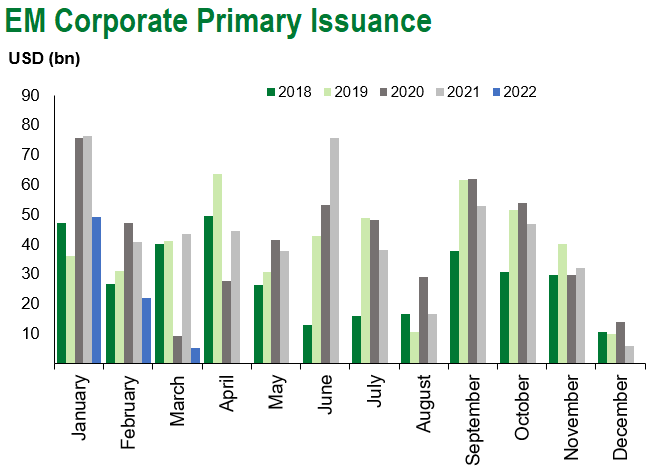
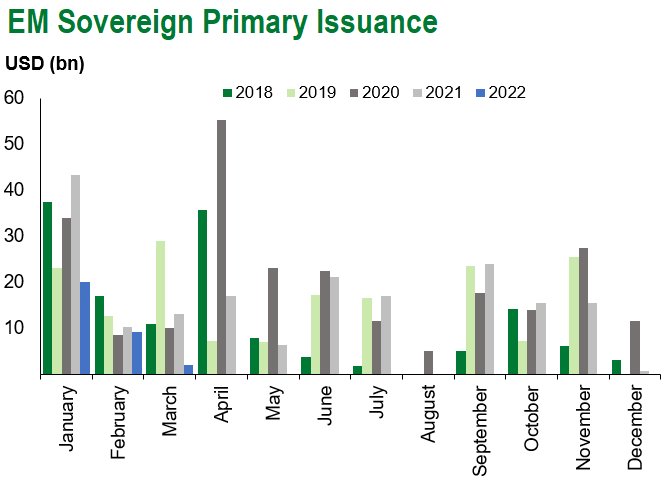
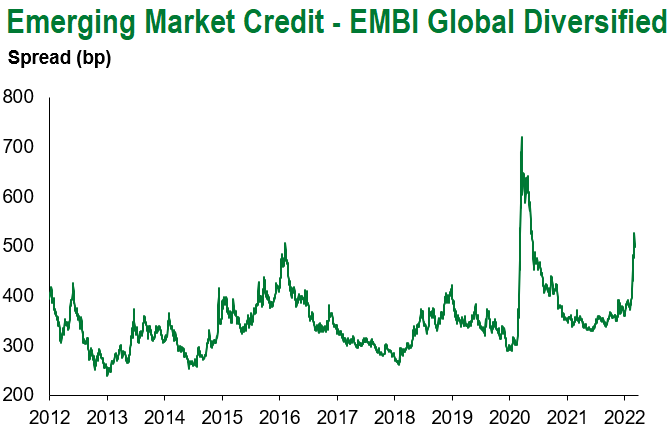
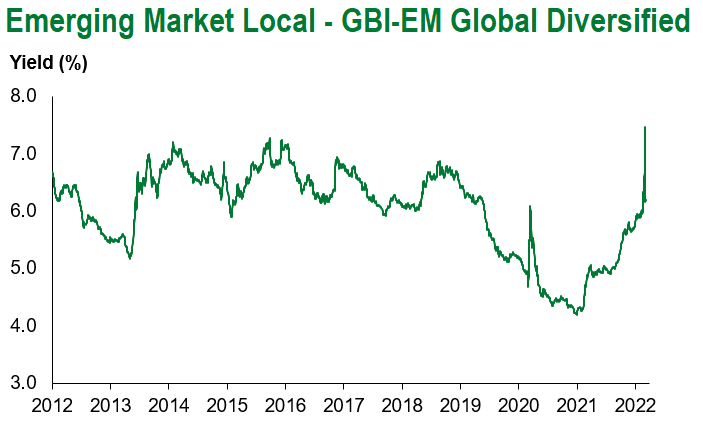
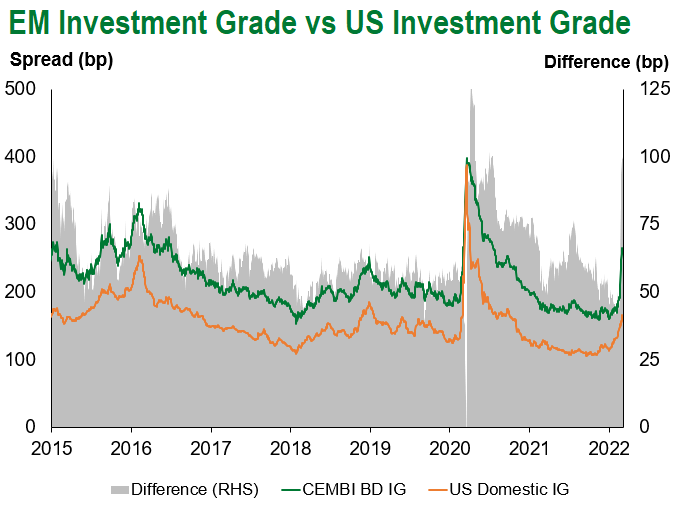
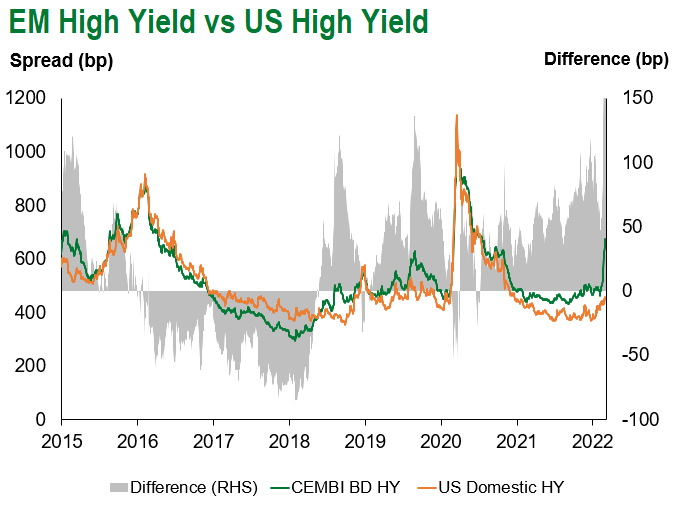
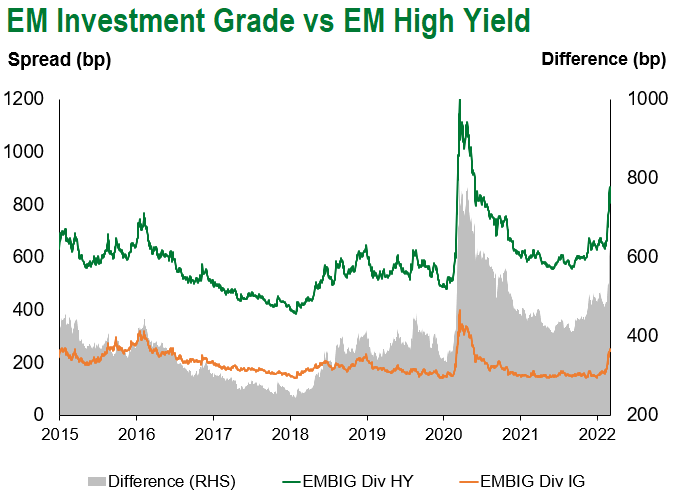
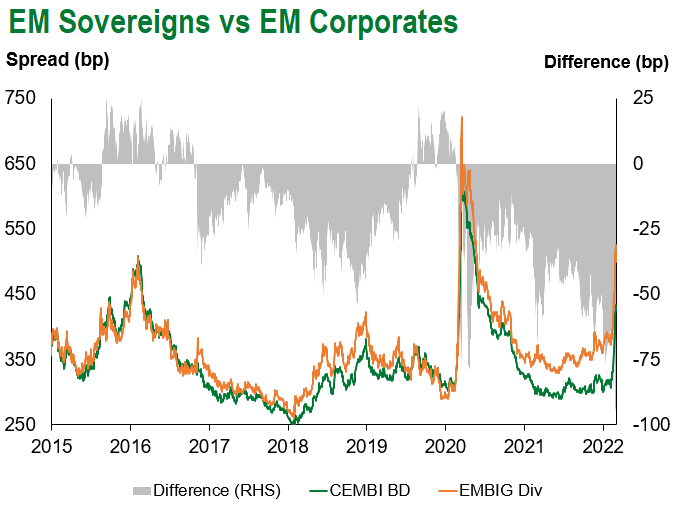
Emerging Markets Flows
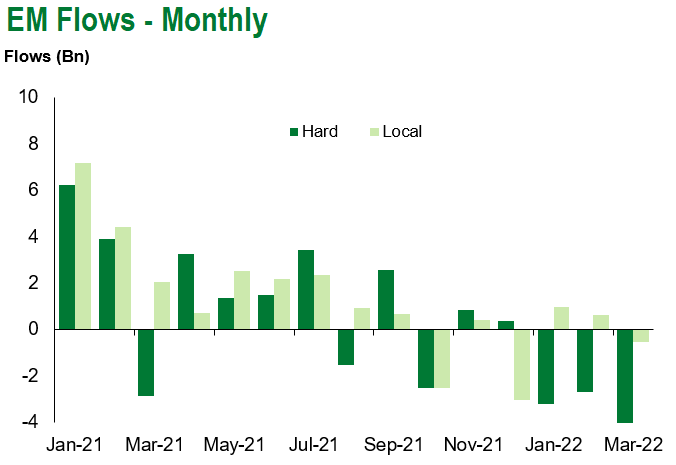
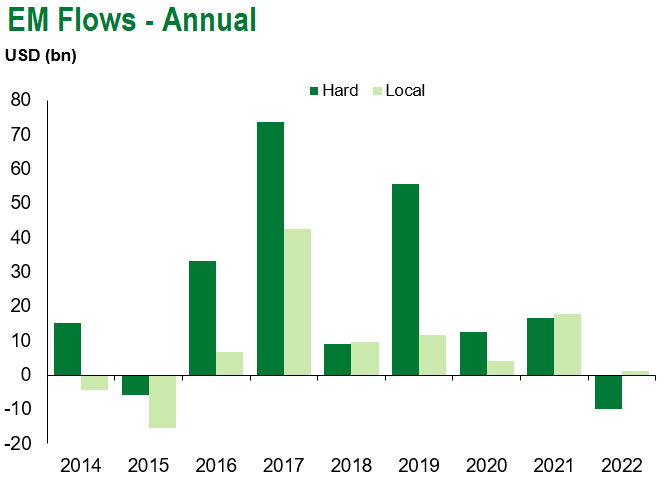
Source for graphs: Bloomberg, JPMorgan, Gramercy. As of March 11, 2022.
COVID Resources
Emerging Markets COVID-19 Case Summary
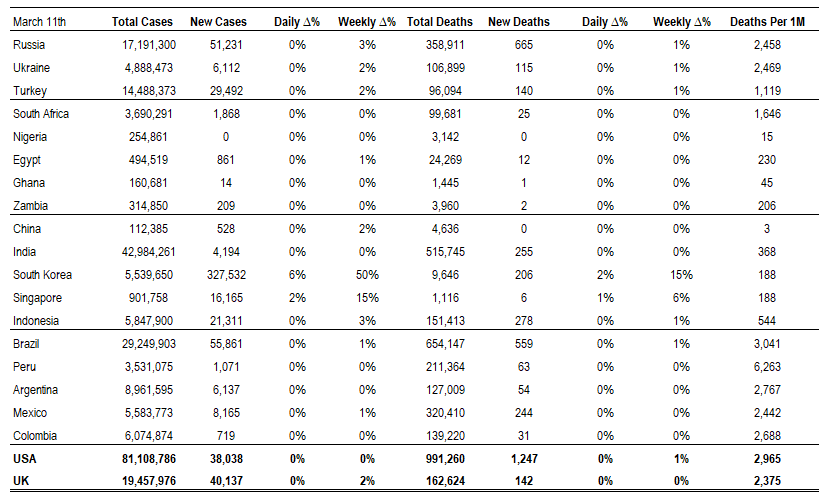
Source: Worldometer as of March 11, 2022.
Additional Crisis Resources:
Johns Hopkins COVID-19 Case Tracker
For questions, please contact:
Kathryn Exum, CFA ESG, Senior Vice President, Sovereign Research Analyst, [email protected]
Petar Atanasov, Senior Vice President, Sovereign Research Analyst, [email protected]
Tolu Alamutu, CFA, Senior Vice President, Corporate Research Analyst, [email protected]
James Barry, Vice President, Corporate Research Analyst, [email protected]
This document is for informational purposes only. The information presented is not intended to be relied upon as a forecast, research or investment advice, and is not a recommendation, offer or solicitation to buy or sell any securities or to adopt any investment strategy. Gramercy may have current investment positions in the securities or sovereigns mentioned above. The information and opinions contained in this paper are as of the date of initial publication, derived from proprietary and nonproprietary sources deemed by Gramercy to be reliable, are not necessarily all-inclusive and are not guaranteed as to accuracy. This paper may contain “forward-looking” information that is not purely historical in nature. Such information may include, among other things, projections and forecasts. There is no guarantee that any forecasts made will come to pass. Reliance upon information in this paper is at the sole discretion of the reader. You should not rely on this presentation as the basis upon which to make an investment decision. Investment involves risk. There can be no assurance that investment objectives will be achieved. Investors must be prepared to bear the risk of a total loss of their investment. These risks are often heightened for investments in emerging/developing markets or smaller capital markets. International investing involves risks, including risks related to foreign currency, limited liquidity, less government regulation, and the possibility of substantial volatility due to adverse political, economic or other developments. The information provided herein is neither tax nor legal advice. Investors should speak to their tax professional for specific information regarding their tax situation.